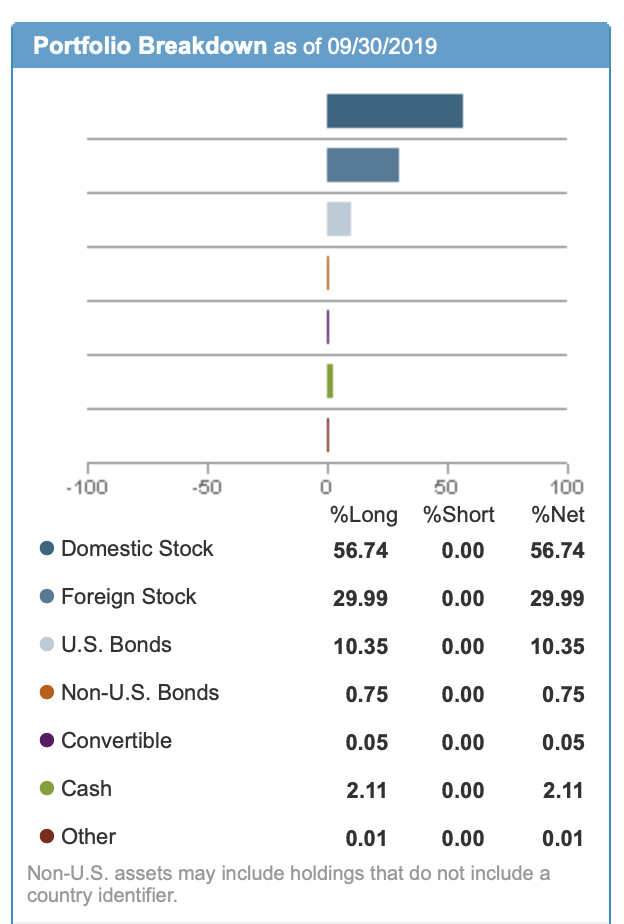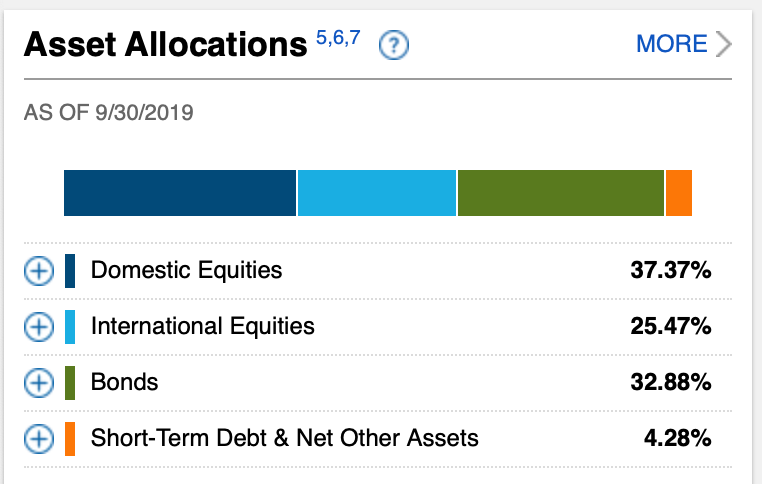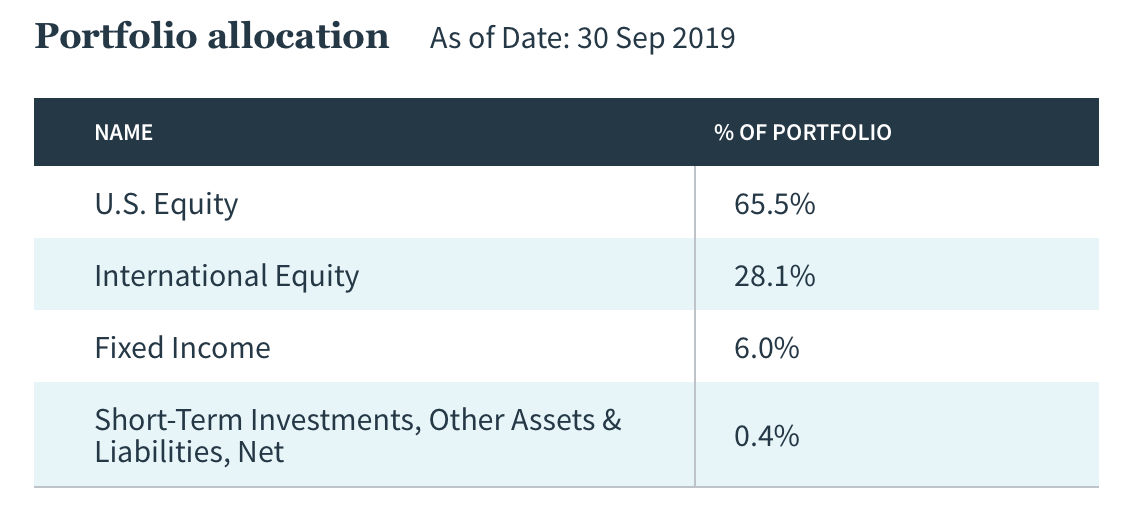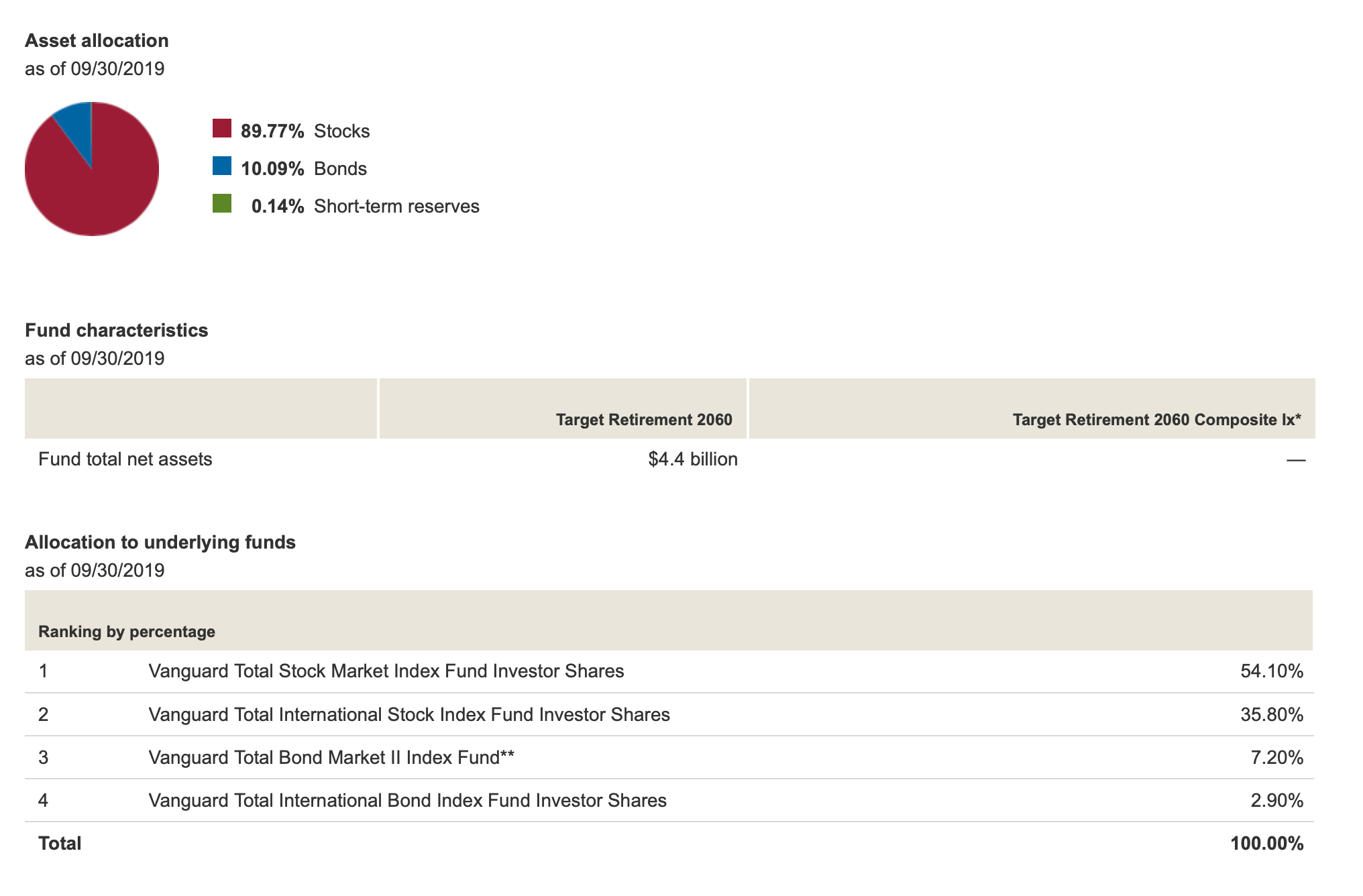What is a Target Date Fund? is a common question among novice investors. A target date fund holds stock and bond index funds and rebalances the relative weight of each asset class over time such that you will start out owning more stocks when you are younger and end up owning more bonds when you are older.
As the allocation between stocks and bonds changes automatically over time, the benefit for you is that you won’t have to think about asset allocation over time. The target date fund will automatically adjust for you as you age.
Target date funds are typically named with the year the owner of such fund is expected to retire. For example, a Target Date Fund 2060 presumes that you will retire in 2060.
Right now, a Target Date Fund 2060 will contain more stocks than bonds on the theory that you have time on your side to take on more risk.
As we get closer to the year 2060, the target date fund will adjust such that ultimately you’ll own more bonds than stocks on the theory that you will be needing the money soon and so cannot afford to take on the risk of stocks.
Who should buy target date funds?
As you long as you purchase low fee target date funds, these are perfect investments for a novice investor. Early in your investing career, the most important thing to do is to get started.
Target date retirement funds let you “set it and forget it” while you focus on building up your investing accounts.
Advanced investors will complain that target date funds often contain unnecessary fees because they are essentially a “meta fund” where you’ll be responsible for paying the fees for all of the underlying mutual funds.
This may be true but there are many extremely low fee mutual funds (see below for some examples).
Regardless, early in your investing career it’s better to focus on your savings rate than minimizing fees.
Paying _slightly_ higher fees for the first five years of your career is not going to prevent you from becoming wealthy. Waiting five years to begin investing is going to cause problems.
Once your account grows to large amount (e.g. $100,000?) you can re-examine whether it makes sense to switch out of the Target Retirement Fund into your own asset allocation.
How do target date funds work?
You can think of Target Date Funds as “meta funds” which hold multiple asset classes.
A typical Target Date Fund will contain separate funds each representing a target asset class such as:
- Total US Equity Market
- Total Non-US Equity Market
- Total US Bond Market
- Total Non-US Bond Market
If you invest in those four asset classes, you’ve effectively invested in the world’s entire equity and bond market.
The Target Date Fund selects an allocation between those four asset classes that is appropriate for your age.
As you get older, the administrator of the Target Date Fund will slowly adjust the asset allocation between those four asset classes.
Meaning the equity funds will decrease over time and the bond portion will increase.
By offloading risk and increasing the amount of bonds you own, you should expect less volatility and lower returns.
That may not sound good but as you get closer to retirement, you want lower volatility and lower returns to ensure that you don’t end up with significantly less money than you thought once you retire.
What are the best target date funds?
Nearly all of the big mutual fund companies offer Target Date Funds.
That means you can expect to find them at places like:
- Vanguard (Target Retirement Funds)
- Schwab (Target Funds)
- Fidelity (Freedom Funds)
- TIAA-Cref (LifeCycle Funds)
Vanguard target retirement fund 2060 (VTTSX)
Let’s look at the Vanguard Target Retirement Fund 2060 (VTTSX).
For a lawyer looking to retire in 2060, Vanguard proposes an asset allocation of approximately 90% stocks and 10% bonds (of which the equity is split 60/40 between the United States and International stock markets and the bonds are split 70/30 between the United States and International bond markets).
Schwab target 2050 index fund (SWYHX)

Here’s a breakdown of Schwab Target 2045 Index Fund (SWYHX).
Schwab is proposing that a lawyer who wants to retire in 2045 should have a little more than 85% in stocks with the balance in bonds and cash.
Fidelity freedom 2025 fund (FFTWX)

Here’s a breakdown of Fidelity Freedom 2025 Fund (FFTWX), which is geared toward an investor who expects to retire in the near future.
As you can see, the asset allocation is completely different.
The Fidelity Freedom 2025 Fund has closer to 60% of the total fund invested in equities and the remaining 40% in bonds and cash.
TIAA-Cref lifecycle index 2060 fund (TVIIX)

Here’s a breakdown of TIAA-Cref Lifecycle Index 2060 Fund (TVIIX).
As we would expect, TIAA-Cref has a more aggressive allocation of nearly 95% in stocks and 5% in bonds given the time horizon.
What fees are associated with target date retirement funds?
Earlier, we talked about Target Date Funds from four of the larger mutual funds companies.
Now, let’s take a look at the fees for each fund. These are the four we explored above:
- Vanguard Target Retirement Fund 2060 (VTTSX)
- Schwab Target 2050 Index Fund (SWYHX)
- Fidelity Freedom 2025 Fund (FFTWX)
- TIAA-Cref Lifecycle Index 2060 Fund (TVIIX)
And here’s those same four Target Date Funds with their annual expense ratio.
- Vanguard Target Retirement Fund 2060 (VTTSX) – 0.15%
- Schwab Target 2050 Index Fund (SWYHX) – 0.08%
- Fidelity Freedom 2025 Fund (FFTWX) – 0.65%
- TIAA-Cref Lifecycle Index 2060 Fund (TVIIX) – 0.10%
What does the expense ratio tells us?
It means that for every $1,000 you have invested, you will pay $1,000 × the expense ratio in fees each year.
For example, Vanguard is charging $1.50 per year per $1,000 in management fees.
If you have $40,000 in the Vanguard fund, you’ll pay $60 a year for them to manage it.
If I were just making a decision on fees, I’d prefer the Schwab Target Date Fund since it charges the lowest fee.
But honestly, all of the fees are fairly low.
Fidelity is the most expensive and you’d still only be paying $260 a year if you had $40,000 invested with them.
Remember that when you’re getting started, your savings rate is way more important than than your investment return or a minor difference in fees.
Focus on piling up as much money as you can today.
And then you can focus on optimizing a portfolio once you have a big balance tomorrow.
Joshua Holt is a former private equity M&A lawyer and the creator of Biglaw Investor. Josh couldn’t find a place where lawyers were talking about money, so he created it himself. He spends 10 minutes a month on Empower keeping track of his money. He’s also maxing out tax-advantaged accounts like 529 Plans to minimize his taxable income.


Nice recap, BLI. Yes, target funds indeed are great. I highly recommend it for investors who don’t want to put in the time or effort to allocate and rebalance a three or four fund portfolio. You could save a few basis points with a three-fund portfolio over a target date fund, but the benefit is minimal for smaller accounts.
I think this is a fine strategy for tax-advantaged accounts, but I think more nuance is needed for taxable accounts. If you are in a high capital gains tax bracket, and you think that at any time in the future, you will want to manage these funds individually, you are better off without the targeted funds. Dealing with capital gains once you realize that you want to micromanage can be a pain. However, for medical/law students, or medical residents (or first year law associates?) this approach is very reasonable in a taxable account, as it may allow for “tax-gain harvesting” while in a lower tax bracket.
I got out of the target funds recently. While it makes sense to have a fund of funds which will have you asset allocation over time adjust for you, I don’t necessarily want to be held to that asset allocation.
Right now, (my 401k options are very limited), I’m in a large cap index fund, a small cap index fund, international equity, and market bond index. I’m going to fund my IRA soon and probably buy a dividend index fund.
Thanks for the post. It’s great to increase my perspective on these types of things.
My 401(k) plan had all high-expense funds in it for the longest time. Recently, they added Vanguard Target Retirement 2055 Fund Investor Shares. The expense ratio is only 0.18, which is just a fraction of what I was paying for their stupid managed funds.
I ran Personal Capital’s fee analyzer before and after and figured out that this change alone should save me over $50,000 in fees over a ten year span… completely insane!
I wish they had other target retirement funds in there so I could aim for my actual retirement date, but it’s a start.
— Jim
I’m not a big fan of these funds. Part of this is culture, I like having control over my investments even if it’s just asset allocation in index funds. Beyond that it’s also because I don’t not feel your length to retirement should be the only factor in your allocation. Some people have more or less risk tolerance then others, no their allocation should reflect accordingly. Still it’s great investment training wheels for those that don’t want to learn about investing. Set and forget. Also for a large portion of the population who through their own actions significantly lag the market, anything that keeps them from making an investment decision is probably a good thing.
I like them. I have them for both my 401-k and my wife’s 403b.
For our IRAs, we use the Vanguard Lifestrategy Growth Fund–I think the Lifestrategy Funds are great too for Retirement accounts.
I’m a big fan of the target date retirement funds. It makes things a lot simpler. However, I think people should probably choose the fund based more on the allocation mix rather than the retirement date. My retirement date is probably closer than the fund I chose because I’m fine with being more aggressive whereas some may want to be more conservative.
Be wary of target date funds, also called ‘funds of funds’. You’ll notice the top holdings inside the target date fund are also mutual funds that have their own set of fees and expenses. Better served to average into an etf(s) or low cost robo than a target date fund in my opinion.
Other than that, great site, lots of helpful info!